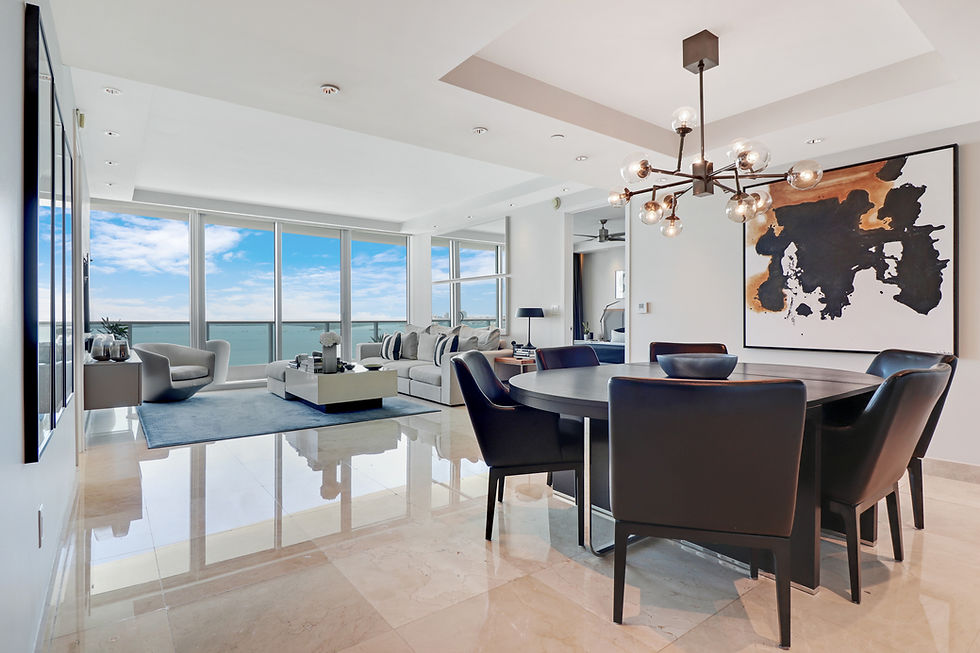Let’s Talk Mental Health: How Your Sanctuary Affects Your Mood
- interioratmosphere

- Feb 12, 2024
- 4 min read

In our fast-paced, modern world, mental health is gaining increasing recognition as a vital component of overall well-being. As interior design professionals, we have a unique role to play in shaping environments that not only please the eye but also nurture the mind. Your home should be more than just a physical space; it should be your sanctuary––a place where you feel safe, relaxed, and at peace. In this article, we'll explore the profound connection between mental health & interior design and how you can leverage this knowledge to create spaces that uplift your mood and promote well-being.
Understanding the Impact of Interior Design on Mental Health
Our surroundings have a profound effect on our mental state. Just think about how you feel when you enter a cluttered, chaotic room versus a clean, well-organized space. The former may induce feelings of stress and anxiety, while the latter can evoke a sense of calm and serenity. Interior design elements such as color, lighting, layout, and even the choice of materials can all influence our moods and emotions.
Color Psychology: Choosing the Right Palette
One of the most powerful tools in interior design is color. Different colors have different psychological effects on our minds. For example, warm tones like reds and oranges can evoke feelings of energy and passion, while cool tones like blues and greens are more calming and soothing. When designing your home, consider the mood you want to create in each space and choose colors accordingly. In areas where you want to promote relaxation, opt for soft, neutral hues, while in spaces meant for socializing or creativity, you can experiment with bolder, more vibrant shades.
Let the Light In: The Importance of Natural Light
Natural light is not only essential for our physical health but also plays a significant role in our mental well-being. Exposure to natural light has been linked to improved mood, increased productivity, and better sleep quality. When designing your home, maximize natural light by choosing large windows and skylights and strategically placing mirrors to reflect light throughout the space. If natural light is limited, consider incorporating artificial lighting that mimics the qualities of sunlight to create a similar effect.
Match Made in Heaven: Creating Functional and Comfortable Spaces
The layout and functionality of a space can also impact our mental health. Clutter and disorganization can contribute to feelings of overwhelm and stress, while a well-designed and organized space promotes a sense of ease and tranquility. Invest in storage solutions that help keep clutter at bay, and carefully consider the flow of each room to ensure that it serves its intended purpose effectively. Additionally, prioritize comfort by choosing furniture and decor that not only looks good but also feels inviting and comfortable to use.
Embrace the Outdoors: Bringing Nature Indoors
Connecting with nature has been shown to have numerous benefits for mental health, including reduced stress and anxiety and improved mood. Incorporating elements of nature into your home design, such as houseplants, natural materials like wood and stone, and views of outdoor greenery, can help create a sense of calm and connection to the natural world. Consider creating a dedicated indoor garden area or adding a living wall to bring the beauty of nature indoors.
Don't Leave Behind Personalization and Self-Expression
Finally, don't underestimate the power of personalization and self-expression in promoting mental well-being. Surrounding yourself with items that hold personal significance, whether it's family photos, artwork, or cherished mementos, can foster a sense of belonging and comfort. When designing your home, don't be afraid to show off your personality and create a space that reflects who you are and what brings you joy.
The Beauty of Incorporating Mindfulness Practices
In addition to the physical aspects of interior design, incorporating mindfulness practices into your home can further enhance your mental well-being. Create designated spaces for activities such as meditation, yoga, or simply quiet contemplation. These spaces can serve as retreats from the hustle and bustle of daily life, allowing you to recharge and center yourself.
While there are many strategies you can employ to design a home that supports your mental health, it can be helpful to seek professional guidance from an interior designer who specializes in this area. A skilled designer can work with you to create a tailored design plan that takes into account your unique needs and preferences, ensuring that your home truly becomes a sanctuary for your mind, body, and soul.
Keep Your Home Sweet Home Exactly That
At the end of the day, the relationship between interior design and mental health is undeniable. By creating spaces that are not only visually pleasing but also functional, comfortable, and personalized to your tastes, you can significantly impact your mood and overall well-being. Whether it's through careful selection of colors, maximizing natural light, or incorporating elements of nature, there are countless ways to design your home to support your mental health. Remember, your home should be your sanctuary—a place where you can escape the stresses of the outside world and find peace, relaxation, and rejuvenation. With thoughtful design and intentionality, you can create a space that nourishes your mind, body, and soul for years to come.




Comments